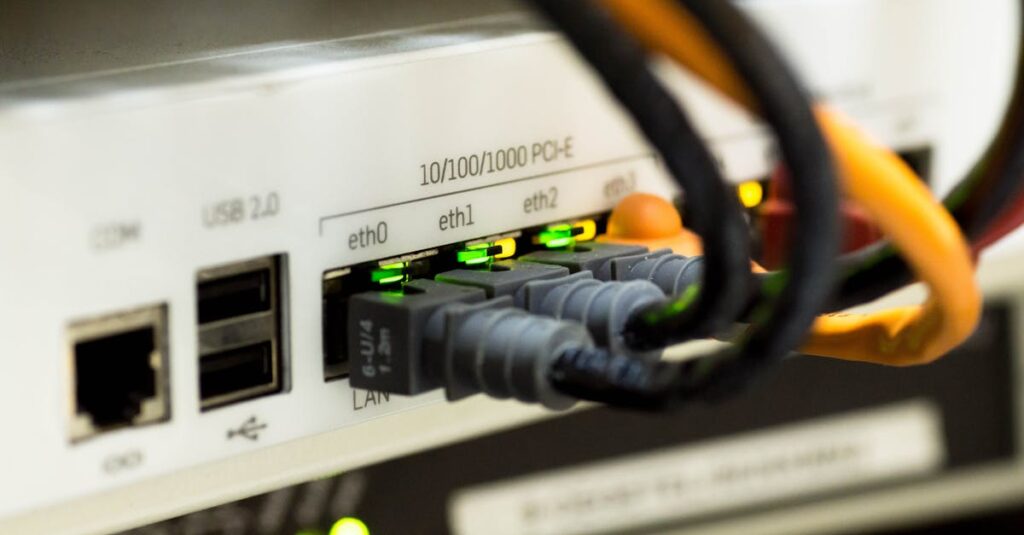In today’s digital jungle, securing your online presence is more important than ever. Enter the router VPN passthrough—a superhero feature that allows your devices to connect to a Virtual Private Network without breaking a sweat. Picture this: your router as a bouncer at an exclusive club, letting only the cool kids (your secure connections) through the door. No one wants to be left out in the cold, especially when it comes to online privacy.
Table of Contents
ToggleWhat Is Router VPN Passthrough?
Router VPN passthrough refers to the capability of a router to allow VPN connection requests from devices on the local network. This feature proves essential for users seeking enhanced online privacy and security while using a VPN service. Firewalls within routers may restrict VPN traffic; thus, passthrough functionality ensures seamless data transmission.
VPN passthrough supports various protocols, such as PPTP, L2TP, and IPSec. Users must confirm that their router’s firmware includes this feature for effective operation. Not all routers come with built-in support for passthrough; some models require configuration changes via the router’s settings interface.
Trusted devices within the network benefit significantly when VPN passthrough is enabled. Improved connections to VPN servers lead to better encryption and protection against digital threats. Most modern routers include VPN passthrough by default, but older models may require user adjustments.
Activating passthrough often involves navigating to the router’s security settings. Users typically find options to allow VPN protocols within these configurations. When using a VPN service, ensuring passthrough is active facilitates straightforward connection establishment on supported devices.
Network administrators commonly manage VPN passthrough settings to maintain strong security protocols. Enhanced security measures include firewall configurations that avoid unauthorized access. Ultimately, router VPN passthrough plays a crucial role in maintaining the integrity and confidentiality of online communications.
How Router VPN Passthrough Works
Router VPN passthrough allows devices within a local network to connect to a Virtual Private Network. This process enhances online privacy and security by enabling seamless data transmission.
Role of VPN Protocols
VPN protocols play a crucial role in establishing secure connections. PPTP, L2TP, and IPSec serve as common protocols that provide varying levels of security and performance. Each protocol has unique features tailored for specific use cases, such as PPTP offering faster speeds with less encryption and IPSec providing robust privacy protections, making it suitable for sensitive data. Understanding the characteristics of these protocols helps users choose the right one for their needs.
Data Flow with VPN Passthrough
Data flow through router VPN passthrough occurs when the router permits VPN traffic to traverse its firewall. Devices within the network send encrypted packets to the VPN server, which decodes them for secure communication. Passthrough functionality allows packets to pass through without alteration, preserving the integrity of the data. Users experience minimal disruption as their Internet traffic accesses the VPN, ensuring smooth connectivity across all devices. This streamlined data flow improves overall network performance while maintaining security protocols, allowing users to surf online confidently.
Benefits of Router VPN Passthrough
Router VPN passthrough provides several advantages for users seeking enhanced online experiences. It ensures that devices connect securely while navigating the internet.
Enhanced Privacy and Security
Enhanced privacy and security stand as primary benefits of router VPN passthrough. When devices connect to a VPN, data travels through an encrypted tunnel, protecting it from potential threats. Users benefit from this security mechanism, which masks their IP addresses and online activities. Additionally, various VPN protocols—like PPTP, L2TP, and IPSec—offer distinct security features tailored to different needs. Such flexibility allows users to choose the most suitable protocol for their specific use cases. Overall, this functionality fosters a safer online environment and significantly reduces the risk of cyberattacks.
Simplified VPN Access
Simplified VPN access is another critical benefit provided by router VPN passthrough. Connectivity becomes effortless as devices within the local network connect to the VPN without extensive configuration. Users gain access with minimal setup, enabling them to maintain secure browsing experiences across multiple devices. Moreover, this feature proves beneficial for households or small businesses, where several devices need protection simultaneously. Users enjoy the convenience of centralized security management, which streamlines access to the VPN. This capability ultimately enhances user satisfaction and fosters a more user-friendly experience when managing online security.
Considerations for Setting Up
Setting up router VPN passthrough requires attention to specific elements. Understanding device compatibility and following the correct configuration steps ensure a smooth operation.
Compatible Routers
Not all routers support VPN passthrough capabilities. Many modern routers come with this feature enabled by default. Users should look for routers that explicitly mention compatible protocols like PPTP, L2TP, or IPSec. Brands such as ASUS, Linksys, and Netgear often provide models equipped for VPN passthrough. Older routers might not support these functionalities, possibly requiring upgrades. Checking the manufacturer’s documentation helps confirm compatibility. Router firmware updates can also enhance support for newer VPN protocols, ensuring better performance.
Configuration Steps
Configuring router VPN passthrough involves several key steps. First, users must access the router’s settings through a web browser. After logging in, navigate to the security settings section. Users should look for VPN passthrough options and ensure they are enabled for the desired protocols. Each router interface varies, so consulting the router’s manual for detailed instructions is crucial. Next, save the changes and reboot the router for updates to take effect. Testing the VPN connection on a device within the network helps verify successful configuration.
Common Issues and Troubleshooting
Users frequently encounter issues with router VPN passthrough that can disrupt their online experience. One common problem involves the router not supporting the desired VPN protocol. If a router lacks compatibility with protocols such as PPTP, L2TP, or IPSec, it may block VPN traffic completely.
Network configuration errors also pose challenges. For instance, incorrect firewall settings can lead to dropped VPN connections. Checking the security options in the router settings ensures compatibility with VPN passthrough and mitigates connection problems.
Another issue revolves around outdated firmware. Routers often require the latest updates for optimal performance and security. Users should confirm that their router’s firmware is up-to-date to resolve potential connectivity issues efficiently.
Moreover, insufficient bandwidth can affect VPN performance. VPN usage typically consumes more bandwidth due to encryption processes. Monitoring bandwidth usage across connected devices helps identify congestion problems that may impact the VPN connection.
Some users may find difficulty in navigating the router’s interface for enabling passthrough. Each router brand, such as ASUS, Linksys, or Netgear, typically features different settings. Consulting the manufacturer’s documentation provides guidance on how to properly enable passthrough.
Lastly, device compatibility issues can arise. Not all devices on the local network may support the chosen VPN protocol. Verifying that client devices meet the necessary requirements assists in establishing successful VPN connections for secure browsing.
Conclusion
Router VPN passthrough is a vital feature for anyone looking to enhance their online security and privacy. By allowing seamless VPN connections, it empowers users to navigate the internet with confidence. Understanding the importance of this functionality ensures that individuals can make informed decisions about their network setup.
With the right configuration and compatible hardware, users can enjoy the benefits of encrypted communication while minimizing potential vulnerabilities. As online threats continue to evolve, leveraging router VPN passthrough becomes essential for maintaining a secure digital environment.




